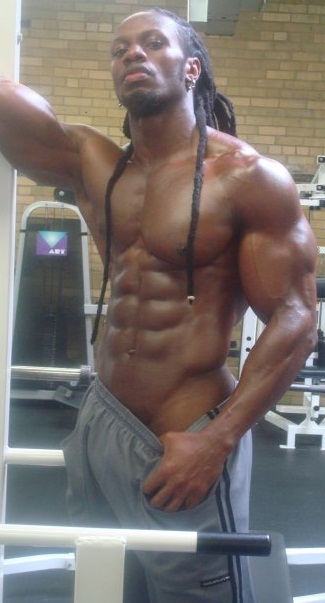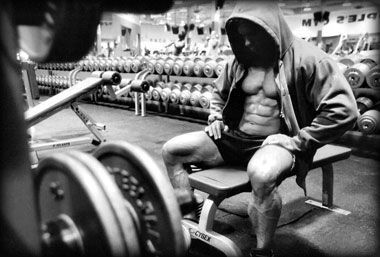
You know that Discovery Channel show “Mythbusters” with the bald mustachioed guy and the redheaded dude who subject popular beliefs to scientific rigor? This is sort of like that only with fewer mustaches and more muscles.
The Plan
We set out to analyze the biggest axioms of bodybuilding training and nutrition to determine which ones can help your physique, which ones can hurt it and which ones help or hurt, depending on your approach.
Once we brought science to bear on each of these 10 tenets, we stamped them TRUE, FALSE or a more nuanced NEUTRAL, meaning the advice is stated too boldly but contains valuable guidance. So, slip into your lab coat, strap on your safety goggles and tighten up your lifting belt, because it’s time to find out the truth and falsity about bodybuilding’s most prevalent maxims.

Myth 10: Don’t Eat Late At Night
Premise
 As much as we may think of bodybuilding as a cloistered subculture, we are forever bombarded with training and nutritional tips from sources far removed from squat racks and posing daises. So it is with this axiom, which is such a ubiquitous feature of the sort of diets Oprah hypes that many beginning bodybuilders dare not breach it, and it breeds confusion about what and when to eat to gain only muscle and not fat.
As much as we may think of bodybuilding as a cloistered subculture, we are forever bombarded with training and nutritional tips from sources far removed from squat racks and posing daises. So it is with this axiom, which is such a ubiquitous feature of the sort of diets Oprah hypes that many beginning bodybuilders dare not breach it, and it breeds confusion about what and when to eat to gain only muscle and not fat.
Science
When you sleep, you’re on a fast. During that fast, your body is forced to turn to your own muscle protein for fuel, converting those amino acids into glucose. In other words, while you’re in dreamland, you’re experiencing the nightmare of cannibalizing your own muscles. The longer you go before sleep without eating, the more your muscle will be eaten away. That’s why we always recommend that you end your day with a slow-digesting protein, such as a casein protein shake or cottage cheese.
 As much as we may think of bodybuilding as a cloistered subculture, we are forever bombarded with training and nutritional tips from sources far removed from squat racks and posing daises. So it is with this axiom, which is such a ubiquitous feature of the sort of diets Oprah hypes that many beginning bodybuilders dare not breach it, and it breeds confusion about what and when to eat to gain only muscle and not fat.
As much as we may think of bodybuilding as a cloistered subculture, we are forever bombarded with training and nutritional tips from sources far removed from squat racks and posing daises. So it is with this axiom, which is such a ubiquitous feature of the sort of diets Oprah hypes that many beginning bodybuilders dare not breach it, and it breeds confusion about what and when to eat to gain only muscle and not fat.Science
When you sleep, you’re on a fast. During that fast, your body is forced to turn to your own muscle protein for fuel, converting those amino acids into glucose. In other words, while you’re in dreamland, you’re experiencing the nightmare of cannibalizing your own muscles. The longer you go before sleep without eating, the more your muscle will be eaten away. That’s why we always recommend that you end your day with a slow-digesting protein, such as a casein protein shake or cottage cheese.
Research from the Weider Research Group discovered that trained bodybuilders drinking a casein protein shake right before bed for eight weeks gained significantly more muscle than those who consumed the same casein shake in the middle of the day.
Verdict
We started with the easiest myth to shoot down, for not only is it OK to chow down long after sundown, it’s crucial to eat a protein meal immediately before going to bed in order to feed your muscles the nutrients they need to recover and grow while you sleep. Go with 20-40 grams of slow-digesting protein, such as a casein shake or cottage cheese. If you’re trying to pack on mass and don’t store fat easily, take your protein with about 20-40 g of slow-digesting carbs, such as oatmeal, sweet potatoes or whole-wheat bread.
We started with the easiest myth to shoot down, for not only is it OK to chow down long after sundown, it’s crucial to eat a protein meal immediately before going to bed in order to feed your muscles the nutrients they need to recover and grow while you sleep. Go with 20-40 grams of slow-digesting protein, such as a casein shake or cottage cheese. If you’re trying to pack on mass and don’t store fat easily, take your protein with about 20-40 g of slow-digesting carbs, such as oatmeal, sweet potatoes or whole-wheat bread.
Myth 9: You Must Train To Failure
Premise
Don’t stop until your muscles stop is like a “No pain, no gain” mantra. Here’s another one: the only rep that counts is the one you can’t finish. In other words, you only stimulate growth by pushing a set to absolute full-rep failure–or beyond–via techniques like forced reps, partials or rest-pause. And thus, HIT zealots are born. This is a popular creed simply because its logic seems irrefutable. After all, if you stop short of failure, won’t you merely do what you were previously capable of doing and thus fail to stimulate growth?
Science
Researchers at the Australian Institute of Sport (Canberra) performed several studies that lead to the conclusion that for strength, doing one set per exercise to failure–and no more–is optimal. When it comes to growth, however, taking most sets to failure appears to be more effective. There is no direct evidence to support this, but research shows that when you do take all sets to failure and beyond with forced reps, growth hormone levels are significantly higher after workouts than when you stop just short of failure. Since GH is critical for muscle growth, it can be assumed that taking most sets to failure is your best bet.
Verdict
Don’t stop until your muscles stop is like a “No pain, no gain” mantra. Here’s another one: the only rep that counts is the one you can’t finish. In other words, you only stimulate growth by pushing a set to absolute full-rep failure–or beyond–via techniques like forced reps, partials or rest-pause. And thus, HIT zealots are born. This is a popular creed simply because its logic seems irrefutable. After all, if you stop short of failure, won’t you merely do what you were previously capable of doing and thus fail to stimulate growth?
Science
Researchers at the Australian Institute of Sport (Canberra) performed several studies that lead to the conclusion that for strength, doing one set per exercise to failure–and no more–is optimal. When it comes to growth, however, taking most sets to failure appears to be more effective. There is no direct evidence to support this, but research shows that when you do take all sets to failure and beyond with forced reps, growth hormone levels are significantly higher after workouts than when you stop just short of failure. Since GH is critical for muscle growth, it can be assumed that taking most sets to failure is your best bet.
Verdict
When training for strengh, take just one set per exercise to failure–no more, no less. For muscle growth, take most sets to failure and beyond with the following tried-and-true Weider Training Principles: forced reps, cheat reps, drop sets, rest-pause and negative reps.

Myth 8: Sugar Is Bad
Premise
 As with nighttime eating, this is another axiom that has been fueled in part by a general dietary consensus. Since your sweet youth–those blissful years of Skittles scarfing and M&M munching–sugar has been the bogeyman of your every meal, promising–if not kept in check–to foster rotting teeth, diabetic shock and a pregnant belly with matching man-boobs. Surely, it has no place in a bodybuilding diet.
As with nighttime eating, this is another axiom that has been fueled in part by a general dietary consensus. Since your sweet youth–those blissful years of Skittles scarfing and M&M munching–sugar has been the bogeyman of your every meal, promising–if not kept in check–to foster rotting teeth, diabetic shock and a pregnant belly with matching man-boobs. Surely, it has no place in a bodybuilding diet.
Science
When you eat sugary foods, they spike your insulin levels. This causes your muscle cells to take up the sugar (glucose in your blood) and store it as glycogen. However, insulin also causes sugar to be taken into fat cells and converted into fat, and it blunts fat burning. So, yes, eating sugar is bad for most meals. One time when sugar is good, though, is immediately after workouts. Those sugary foods get into your blood stream ASAP, so your muscles can refuel.
 As with nighttime eating, this is another axiom that has been fueled in part by a general dietary consensus. Since your sweet youth–those blissful years of Skittles scarfing and M&M munching–sugar has been the bogeyman of your every meal, promising–if not kept in check–to foster rotting teeth, diabetic shock and a pregnant belly with matching man-boobs. Surely, it has no place in a bodybuilding diet.
As with nighttime eating, this is another axiom that has been fueled in part by a general dietary consensus. Since your sweet youth–those blissful years of Skittles scarfing and M&M munching–sugar has been the bogeyman of your every meal, promising–if not kept in check–to foster rotting teeth, diabetic shock and a pregnant belly with matching man-boobs. Surely, it has no place in a bodybuilding diet.Science
When you eat sugary foods, they spike your insulin levels. This causes your muscle cells to take up the sugar (glucose in your blood) and store it as glycogen. However, insulin also causes sugar to be taken into fat cells and converted into fat, and it blunts fat burning. So, yes, eating sugar is bad for most meals. One time when sugar is good, though, is immediately after workouts. Those sugary foods get into your blood stream ASAP, so your muscles can refuel.
By spiking insulin at a time when you want it spiked, it won’t convert sugar into fat, but instead, it’ll drive that sugar into muscle cells along with amino acids, which build more muscle. And insulin will turn on the process of protein synthesis, which is how muscles grow.
Verdict
Sugar is the Jekyll and Hyde of nutrients. Most of the time, it lives up to its bad rep, but immediately after training it’s the good guy, because it spikes your insulin levels and drives protein to your muscle cells. Avoid sugar most of the time, but not after you work out–that’s when you should consume about 40 g of a protein shake and 40-100 g of sugary foods or drinks.
Sugar is the Jekyll and Hyde of nutrients. Most of the time, it lives up to its bad rep, but immediately after training it’s the good guy, because it spikes your insulin levels and drives protein to your muscle cells. Avoid sugar most of the time, but not after you work out–that’s when you should consume about 40 g of a protein shake and 40-100 g of sugary foods or drinks.
Myth 7: You Can Only Digest 30grams Of Protein Per Meal
Premise
 We’re not exactly certain when or where this belief originated, but it became especially prevalent among bodybuilders in the ’80s and has persisted ever since. It is a valid reminder to eat smaller portions more frequently throughout the day as opposed to three big, calorie-laden meals, but it makes a bold and specific claim about the abilities of everyone’s digestive system. Is 30 g the protein limit?
We’re not exactly certain when or where this belief originated, but it became especially prevalent among bodybuilders in the ’80s and has persisted ever since. It is a valid reminder to eat smaller portions more frequently throughout the day as opposed to three big, calorie-laden meals, but it makes a bold and specific claim about the abilities of everyone’s digestive system. Is 30 g the protein limit?
Science
How much protein you can digest and utilize depends on numerous factors, such as your gastrointestinal tract’s digestion and absorption abilities, how much muscle recovery your body has to do, how much protein you have recently eaten, and how many calories you are getting from carbohydrates and fat. In fact, a French study of elderly women subjects found that, in the group that ate one huge meal containing about 50g of protein, protein synthesis was significantly higher than in another group that ate an equivalent amount of protein spread over several meals.
Verdict
 We’re not exactly certain when or where this belief originated, but it became especially prevalent among bodybuilders in the ’80s and has persisted ever since. It is a valid reminder to eat smaller portions more frequently throughout the day as opposed to three big, calorie-laden meals, but it makes a bold and specific claim about the abilities of everyone’s digestive system. Is 30 g the protein limit?
We’re not exactly certain when or where this belief originated, but it became especially prevalent among bodybuilders in the ’80s and has persisted ever since. It is a valid reminder to eat smaller portions more frequently throughout the day as opposed to three big, calorie-laden meals, but it makes a bold and specific claim about the abilities of everyone’s digestive system. Is 30 g the protein limit?Science
How much protein you can digest and utilize depends on numerous factors, such as your gastrointestinal tract’s digestion and absorption abilities, how much muscle recovery your body has to do, how much protein you have recently eaten, and how many calories you are getting from carbohydrates and fat. In fact, a French study of elderly women subjects found that, in the group that ate one huge meal containing about 50g of protein, protein synthesis was significantly higher than in another group that ate an equivalent amount of protein spread over several meals.
Verdict
There is a limit to how much protein you can digest at any one time. and this is a principal reason for eating six or more meals daily, but 30 g is arbitrarily low. Aim for 1-1.5 g of protein daily for every pound of your bodyweight and spread this over six meals (including shakes). For example, if you weigh 210 pounds, that would be an average of 35-52 g of protein per meal.
Myth 6: You Can’t Gain Muscle & Lose Fat At The Same Time
Premise
 This is a logical extension of the belief that you have to consume more calories than normal to gain muscle and consume fewer calories than normal to shed fat. Therefore, it follows that you must choose between the two. Such thinking has spawned a million bulking phases and a few fewer cutting cycles.
This is a logical extension of the belief that you have to consume more calories than normal to gain muscle and consume fewer calories than normal to shed fat. Therefore, it follows that you must choose between the two. Such thinking has spawned a million bulking phases and a few fewer cutting cycles.
Science
Although it is much harder to gain muscle when your calories are low enough to stimulate fat loss, it is possible. This is especially true when protein intake is high, carbohydrates are low and adequate protein is eaten at the four most critical times of day: first thing in the morning, before and after work outs, and before bed. In fact, researchers from the University of Connecticut (Storrs) investing a very low-carb diet reported that men following the diet without exercise lost a significant amount of bodyfat while gaining lean muscle.
 This is a logical extension of the belief that you have to consume more calories than normal to gain muscle and consume fewer calories than normal to shed fat. Therefore, it follows that you must choose between the two. Such thinking has spawned a million bulking phases and a few fewer cutting cycles.
This is a logical extension of the belief that you have to consume more calories than normal to gain muscle and consume fewer calories than normal to shed fat. Therefore, it follows that you must choose between the two. Such thinking has spawned a million bulking phases and a few fewer cutting cycles.Science
Although it is much harder to gain muscle when your calories are low enough to stimulate fat loss, it is possible. This is especially true when protein intake is high, carbohydrates are low and adequate protein is eaten at the four most critical times of day: first thing in the morning, before and after work outs, and before bed. In fact, researchers from the University of Connecticut (Storrs) investing a very low-carb diet reported that men following the diet without exercise lost a significant amount of bodyfat while gaining lean muscle.
In addition to dieting, use supplements that promote muscle growth, such as creatine, branched chain amino acids, arginine and beta-alanine.
Verdict
Yes, you can go in two directions at the same time Just as you can (hope-fully) chew gum and walk simultaneously, you can both add lean mass and subtract the unwanted bodyfat during the same time period via the correct combination of protein, carbs, supplements, weight training and cardio. The result? A bigger, better you.
Yes, you can go in two directions at the same time Just as you can (hope-fully) chew gum and walk simultaneously, you can both add lean mass and subtract the unwanted bodyfat during the same time period via the correct combination of protein, carbs, supplements, weight training and cardio. The result? A bigger, better you.
Myth 5: Do Cardio After Weight Training
Premise
 Most bodybuilders get on s StepMill or stationary bike after hitting the weights for no better reason than they’d rather do the latter than the former. They make certain they’ve done all they can to boost muscle growth before doing what they can to reduce blubber, and yet they may feel they’ve shortchanged their fat burning by focusing first on maximizing their muscle burn.
Most bodybuilders get on s StepMill or stationary bike after hitting the weights for no better reason than they’d rather do the latter than the former. They make certain they’ve done all they can to boost muscle growth before doing what they can to reduce blubber, and yet they may feel they’ve shortchanged their fat burning by focusing first on maximizing their muscle burn.
Science
Japanse researchers found that when subjects performed cardio immediately weight training, the amount of fat burning was significantly higher than when they did cardio first. This may be due to something that the same Japanese researches found in another study–when you hit the weights first, growth hormone levels are higher.
 Most bodybuilders get on s StepMill or stationary bike after hitting the weights for no better reason than they’d rather do the latter than the former. They make certain they’ve done all they can to boost muscle growth before doing what they can to reduce blubber, and yet they may feel they’ve shortchanged their fat burning by focusing first on maximizing their muscle burn.
Most bodybuilders get on s StepMill or stationary bike after hitting the weights for no better reason than they’d rather do the latter than the former. They make certain they’ve done all they can to boost muscle growth before doing what they can to reduce blubber, and yet they may feel they’ve shortchanged their fat burning by focusing first on maximizing their muscle burn.Science
Japanse researchers found that when subjects performed cardio immediately weight training, the amount of fat burning was significantly higher than when they did cardio first. This may be due to something that the same Japanese researches found in another study–when you hit the weights first, growth hormone levels are higher.
GH not only promotes muscle growth, but also liberates fat from fat cells so that it can be burned away for fuel.
Verdict
Feel no guilt about doing cardio after weight training, because it’s the best strategy for both muscle growth and fat zapping.
Feel no guilt about doing cardio after weight training, because it’s the best strategy for both muscle growth and fat zapping.
Myth 4: Dietary Fat Is Bad
Premise
 Sugar isn’t the only nutrient on most bodybuilders’ sh–t list. Fat is usually even higher on the dishonor roll. After all, sugar has pleasing connotations, but fat–unless it’s phat–always seems bad. The fact that bodybuilding diets emphasize lean protein sources, such as egg whites, turkey, chicken breasts and fat-free dairy products is enough to make any (extra-lean) meathead scan every label for a dreaded gram of F-A-T.
Sugar isn’t the only nutrient on most bodybuilders’ sh–t list. Fat is usually even higher on the dishonor roll. After all, sugar has pleasing connotations, but fat–unless it’s phat–always seems bad. The fact that bodybuilding diets emphasize lean protein sources, such as egg whites, turkey, chicken breasts and fat-free dairy products is enough to make any (extra-lean) meathead scan every label for a dreaded gram of F-A-T.
Science
There’s only one type of fat you want to avoid at all costs: trans fat. This man-made fat is not only bad for your health, but it can increase muscle breakdown. Think saturated fat is the scourge of the American diet? Not for you. In fact, you need a good 10% of total daily calories from saturated fat (such as in beef) to promote testosterone levels. And you need about 30% of your total calories from fats, as research shows that athletes getting lower fat intake have lower testosterone levels.
 Sugar isn’t the only nutrient on most bodybuilders’ sh–t list. Fat is usually even higher on the dishonor roll. After all, sugar has pleasing connotations, but fat–unless it’s phat–always seems bad. The fact that bodybuilding diets emphasize lean protein sources, such as egg whites, turkey, chicken breasts and fat-free dairy products is enough to make any (extra-lean) meathead scan every label for a dreaded gram of F-A-T.
Sugar isn’t the only nutrient on most bodybuilders’ sh–t list. Fat is usually even higher on the dishonor roll. After all, sugar has pleasing connotations, but fat–unless it’s phat–always seems bad. The fact that bodybuilding diets emphasize lean protein sources, such as egg whites, turkey, chicken breasts and fat-free dairy products is enough to make any (extra-lean) meathead scan every label for a dreaded gram of F-A-T.Science
There’s only one type of fat you want to avoid at all costs: trans fat. This man-made fat is not only bad for your health, but it can increase muscle breakdown. Think saturated fat is the scourge of the American diet? Not for you. In fact, you need a good 10% of total daily calories from saturated fat (such as in beef) to promote testosterone levels. And you need about 30% of your total calories from fats, as research shows that athletes getting lower fat intake have lower testosterone levels.
A good portion of this should come from monounsaturated fats (olive oil, avocadoes, nuts) and omega-3 fats (salmon, trout). These fats are not readily stored as bodyfat, are easily burned for fuel during exercise and even stimulate the burning of bodyfat.
Verdict
Avoid trans fats at all cost, but be sure to get about 30% of total calories from fat with about 10% from saturated fat, 10% from monounsaturated fat and 10% from omega-3 fats.
Avoid trans fats at all cost, but be sure to get about 30% of total calories from fat with about 10% from saturated fat, 10% from monounsaturated fat and 10% from omega-3 fats.
Myth 3: Always Stretch Before Training
Premise
Apostles of exercise preach this one so relentlessly that you may wonder why it’s even appearing on this page. If you haven’t been reading bodybuilding magazines in recent years, you likely think there is no debate about stretching before hitting the iron. It’s true that there is no longer any debate, but you may be surprised by what has been decided.
Science
Contrary to popular belief, there are no studies showing that stretching before exercise reduces the risk of injury. There is, however, an abundance of research demonstrating that when athletes do static stretching (the sort where you reach and hold) before weight training, their strength decreases. Further studies show that flexibility increases more when such stretching is done after exercise as opposed to before it. Those three facts would seem to explode one of exercise’s biggest bugaboos. Not so fast, however, because still more research shows that dynamic stretching (fast, ballistic movements, such as arm circles for shoulders and high kicks for legs) before weight training increases power and strength.
Verdict
Apostles of exercise preach this one so relentlessly that you may wonder why it’s even appearing on this page. If you haven’t been reading bodybuilding magazines in recent years, you likely think there is no debate about stretching before hitting the iron. It’s true that there is no longer any debate, but you may be surprised by what has been decided.
Science
Contrary to popular belief, there are no studies showing that stretching before exercise reduces the risk of injury. There is, however, an abundance of research demonstrating that when athletes do static stretching (the sort where you reach and hold) before weight training, their strength decreases. Further studies show that flexibility increases more when such stretching is done after exercise as opposed to before it. Those three facts would seem to explode one of exercise’s biggest bugaboos. Not so fast, however, because still more research shows that dynamic stretching (fast, ballistic movements, such as arm circles for shoulders and high kicks for legs) before weight training increases power and strength.
Verdict
Don’t do traditional static stretching before training. Do it after your workout, holding each stretch for approximately 30 seconds. Before your workout, perform dynamic stretches as part of your warm-up.

Myth 2: You Must Train Heavy To Grow
Premise
As with always training to failure, this is again the sort of saying you’d expect to find on a tattered poster taped to a cragged gym wall or shouted by spotters before someone tries to do a personal-best triple in the squat. We’re all for using it as an incentive to “man up” and drive yourself through your hardest sets, but if we start with the premise that heavy is a relative term–that what’s heavy to you won’t be to Ronnie Coleman–then heavy is a reflection of how few reps you do before reaching failure. Therefore, the question arises: Are maximum sets of low reps (fewer than eight) the best strategy for muscle growth?
Science
Research confirms that reps in the range of one to seven are best for building strength, but not necessarily for muscle growth. Stopping at this many reps instigates the nerves that stimulate the muscles to fire stronger and more synchronously–critical for muscle growth. However, so few reps do not stimulate adequate metabolic changes in the muscle for growth. To do so, you need to keep reps in the eight to 12 range. This increases the production of metabolic byproducts in the muscle, such as lactic acid, which stimulates the production of GH. These metabolic byproducts also draw water inside the muscle cells to create the pump, which stretches the muscle and turns on growth processes.
Verdict
As with always training to failure, this is again the sort of saying you’d expect to find on a tattered poster taped to a cragged gym wall or shouted by spotters before someone tries to do a personal-best triple in the squat. We’re all for using it as an incentive to “man up” and drive yourself through your hardest sets, but if we start with the premise that heavy is a relative term–that what’s heavy to you won’t be to Ronnie Coleman–then heavy is a reflection of how few reps you do before reaching failure. Therefore, the question arises: Are maximum sets of low reps (fewer than eight) the best strategy for muscle growth?
Science
Research confirms that reps in the range of one to seven are best for building strength, but not necessarily for muscle growth. Stopping at this many reps instigates the nerves that stimulate the muscles to fire stronger and more synchronously–critical for muscle growth. However, so few reps do not stimulate adequate metabolic changes in the muscle for growth. To do so, you need to keep reps in the eight to 12 range. This increases the production of metabolic byproducts in the muscle, such as lactic acid, which stimulates the production of GH. These metabolic byproducts also draw water inside the muscle cells to create the pump, which stretches the muscle and turns on growth processes.
Verdict
Not only do you not have to train heavy to grow, but it’s not the best rep range for growth. That would be the moderate range of eight to 12 reps. We recommend varying your reps with some low and some high, but keep most in the sweet spot in the middle.

Myth 1: Don’t Train When Your Sore
Premise
 The number one bodybuilding myth seems so logical and has been promulgated so successfully for so long that you may be stunned to find it here–and that’s precisely why it landed in the top spot. If DOMS (delayed onset muscle soreness–the ache you typically feel 24 to 48 hours after intense training) indicates that your muscle cells are, in effect, broken down from your previous workout, then why would you want to train again while still sore?
The number one bodybuilding myth seems so logical and has been promulgated so successfully for so long that you may be stunned to find it here–and that’s precisely why it landed in the top spot. If DOMS (delayed onset muscle soreness–the ache you typically feel 24 to 48 hours after intense training) indicates that your muscle cells are, in effect, broken down from your previous workout, then why would you want to train again while still sore?
Science
DOMS signifies normal processes in the muscles that are involved in muscle recovery and growth. One study found that when subjects followed an exercise session that caused muscle soreness with another exercise session about two days later–while still sore–their cortisol levels (a catabolic hormone that interferes with muscle growth) were much lower than the first workout and free testosterone was slightly higher. In other words, they were in a better anabolic state. In addition, Japanese researchers induced soreness in the biceps muscles of subjects with heavy negative rep curls, and repeated the exercise two and four days later.
 The number one bodybuilding myth seems so logical and has been promulgated so successfully for so long that you may be stunned to find it here–and that’s precisely why it landed in the top spot. If DOMS (delayed onset muscle soreness–the ache you typically feel 24 to 48 hours after intense training) indicates that your muscle cells are, in effect, broken down from your previous workout, then why would you want to train again while still sore?
The number one bodybuilding myth seems so logical and has been promulgated so successfully for so long that you may be stunned to find it here–and that’s precisely why it landed in the top spot. If DOMS (delayed onset muscle soreness–the ache you typically feel 24 to 48 hours after intense training) indicates that your muscle cells are, in effect, broken down from your previous workout, then why would you want to train again while still sore?Science
DOMS signifies normal processes in the muscles that are involved in muscle recovery and growth. One study found that when subjects followed an exercise session that caused muscle soreness with another exercise session about two days later–while still sore–their cortisol levels (a catabolic hormone that interferes with muscle growth) were much lower than the first workout and free testosterone was slightly higher. In other words, they were in a better anabolic state. In addition, Japanese researchers induced soreness in the biceps muscles of subjects with heavy negative rep curls, and repeated the exercise two and four days later.
Verdict Research shows that you typically need 48 to 72 hours between workouts to fully recover, and you can then train the same muscles again. This is regardless of whether or not you feel sore.They found no significant differences in max strength, range of motion, muscle soreness and plasma creatine kinase (a chemical indicator of muscle damage) between each exercise bout. In other words, muscle damage wasn’t made worse by the back-to-back training.
No comments:
Post a Comment